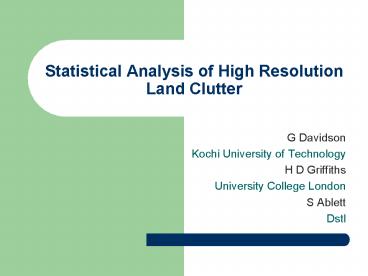Statistical Analysis of High Resolution Land Clutter - PowerPoint PPT Presentation
1 / 18
Title:
Statistical Analysis of High Resolution Land Clutter
Description:
96 Azimuth Swaths, 500 Range Gates, 128 Frequencies, Repeated 32 times, For 7 ... 100m azimuth resolution. Glen Davidson - Radar 2002. 5. Distribution Analysis ... – PowerPoint PPT presentation
Number of Views:76
Avg rating:3.0/5.0
Title: Statistical Analysis of High Resolution Land Clutter
1
Statistical Analysis of High Resolution Land
Clutter
- G Davidson
- Kochi University of Technology
- H D Griffiths
- University College London
- S Ablett
- Dstl
2
Overview
- Large amount of Byson C-band (VV) frequency agile
radar data operated in mixed clutter environment
of Worcester. - Analysis suggests that no single distribution
fits well. - Dominated by varying statistics including
non-stationarity, clutter edges and
discontinuities related to environment. - Due to instrumental effects and sample
uncertainty, performance predictions were
erroneous. - Show a 7dB detection gain (Pfa of 10-4) possible
when the normalised log estimate U is used as a
measure of uncertainty. Proposed CFAR has a
variable threshold multiplier as an empirical
function of U. - Uses real data to include all instrumental
effects.
3
Aim
Intensity
Terrain Height
- Analyse high resolution data and determine
possible target detection gain from using
non-Gaussian statistics.
4
Data Acquisition
- Frequency Agile 30m
- Pulse compression into range cells of 1 metre.
- 96 Azimuth Swaths,500 Range Gates,128
Frequencies,Repeated 32 times,For 7
attenuations - Total 1?109 samples
- 100m azimuth resolution
- The natural local statistics to analyse were the
100 compressed range cells within each range gate.
5
Distribution Analysis
- Normalised log estimate U reasonable for both K
and Weibull
Shape parameter
(Blacknell, Oliver)
6
Dynamic Range Digitisation
Gaussian U -1 U -2 U -3 U -4 U -5 U
-6 Spiky
- Byson instrumentation has a strong effect upon U
7
Individual Gate Attenuation
- 0dB to 50dB attenuation required over entire scene
8
U Measured for Entire Scene
- Wide variation in U but Motorway and Railway
visible
9
Range Cell Traces
Motorway (dB)
Open Area (linear)
- Two cases with identical measured U obviously
have very different statistics and may not be
Independent Identically Distributed
10
Step Effect upon U
10dB 15dB 20dB
- Steps in the data seriously alter the estimate of
U, such that the clutter variance is
over-estimated
11
Edge Corrupted or K?
Edges
Stable K
Edge Present Stable Gaussian Stable K
12
Scene Likelihood Analysis
Edge-like
log10 likelihood
K-like
- More edge-corrupted speckle than K, except
motorway is visibly K-like.
13
Detection Algorithm
- Postulate Distribution
Environmental, Weibull, K, ??
- Estimate Shape
Low sample number, edge corruption
- N-sum Distribution
Mathematically intractable, stability over
time/range
- Pfa Calculation
Mathematical architecture choice
- Pd Calculation
Monte Carlo often used
- Dynamic Range, Digitisation, Pulse Compression
14
Empirical Method
Gaussian
Spiky
- Empirical distributions are already used
(Weibull). A large dataset means the mathematics
can be avoided by directly mapping the shape
estimate to the required threshold.
15
Fixed Multiplier CFAR
Intensity
Range
- Threshold multiplier chosen for Pfa of 10-4 over
scene
16
Variable Multiplier CFAR
U
Intensity
Range
U
- Threshold multiplier now a function of U for Pfa
of 10-4
17
Real Data/Simulated Target
- 16 Pulse CFAR
- 4 Guard Cells
- Pfa 10-4
- Swerling 0 target
7dB
- At Pd 0.5 7dB target gain
18
Conclusions
- Land data can be so variable that the concept of
a stable statistical distribution is not useful
for small sample numbers. - Normalised log estimator U can illustrate this
variability, but it is susceptible to edges,
digitisation and small samples. - Likelihood analysis suggested that a large
proportion is affected by edges, but CAGO didnt
help. - Fixed multiplier CFAR false alarms dominated by
motorway and other spiky areas strongly
correlated to environment. - Instead of empirically fitting distributions such
as Weibull to single pulse data, weve
empirically fitted the required threshold for a
variable multiplier CFAR architecture as f(U). - When all instrumentation effects are included,
still see a 7dB improvement in performance.
Normalised log U is useful as a general measure
of uncertainty.































